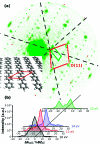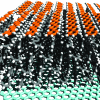Smooth growth of organic semiconductor films on graphene for high-efficiency electronics
- PMID: 21207968
- PMCID: PMC3036005
- DOI: 10.1021/nl103739n
Smooth growth of organic semiconductor films on graphene for high-efficiency electronics
Abstract
High-quality thin films of conjugated molecules with smooth interfaces are important to assist the advent of organic electronics. Here, we report on the layer-by-layer growth of the organic semiconductor molecule p-sexiphenyl (6P) on the transparent electrode material graphene. Low energy electron microscopy and micro low energy electron diffraction reveal the morphological and structural evolution of the thin film. The layer-by-layer growth of 6P on graphene proceeds by subsequent adding of {111} layers.
Figures





Similar articles
-
Clean graphene electrodes on organic thin-film devices via orthogonal fluorinated chemistry.Nano Lett. 2015 Apr 8;15(4):2555-61. doi: 10.1021/acs.nanolett.5b00110. Epub 2015 Mar 23. Nano Lett. 2015. PMID: 25774924
-
Transfer of large-area graphene films for high-performance transparent conductive electrodes.Nano Lett. 2009 Dec;9(12):4359-63. doi: 10.1021/nl902623y. Nano Lett. 2009. PMID: 19845330
-
Mesoporous silica nanolayers infiltrated with hole-transporting molecules for hybrid organic light-emitting devices.ACS Nano. 2008 Jun;2(6):1137-42. doi: 10.1021/nn7003124. ACS Nano. 2008. PMID: 19206331
-
Graphene synthesis: relationship to applications.Nanoscale. 2013 Jan 7;5(1):38-51. doi: 10.1039/c2nr32629a. Epub 2012 Nov 19. Nanoscale. 2013. PMID: 23160190 Review.
-
Synthesis of graphene-conjugated polymer nanocomposites for electronic device applications.Nanoscale. 2013 Feb 21;5(4):1440-51. doi: 10.1039/c2nr33145d. Nanoscale. 2013. PMID: 23325111 Review.
Cited by
-
Avogadro: an advanced semantic chemical editor, visualization, and analysis platform.J Cheminform. 2012 Aug 13;4(1):17. doi: 10.1186/1758-2946-4-17. J Cheminform. 2012. PMID: 22889332 Free PMC article.
-
Mechanism of Carrier Formation in P3HT-C60-PCBM Solar Cells.Nanomaterials (Basel). 2024 Aug 28;14(17):1400. doi: 10.3390/nano14171400. Nanomaterials (Basel). 2024. PMID: 39269062 Free PMC article.
-
Epitaxy of highly ordered organic semiconductor crystallite networks supported by hexagonal boron nitride.Sci Rep. 2016 Dec 8;6:38519. doi: 10.1038/srep38519. Sci Rep. 2016. PMID: 27929042 Free PMC article.
-
Epitaxial growth of π-stacked perfluoropentacene on graphene-coated quartz.ACS Nano. 2012 Dec 21;6(12):10874-83. doi: 10.1021/nn3042607. Epub 2012 Nov 26. ACS Nano. 2012. PMID: 23181564 Free PMC article.
-
Comparing the Self-Assembly of Sexiphenyl-Dicarbonitrile on Graphite and Graphene on Cu(111).Chemistry. 2019 Apr 1;25(19):5065-5070. doi: 10.1002/chem.201806312. Epub 2019 Mar 12. Chemistry. 2019. PMID: 30657213 Free PMC article.
References
-
- Chiang C. K.; Fincher C. R.; Park Y. W.; Heeger A. J.; Shirakawa H.; Louis E. J.; Gau S. C.; MacDiarmid A. G. Phys. Rev. Lett. 1977, 39, 1098–1101.
-
- Dodabalapur A.; Torsi L.; Katz H. E. Science 1995, 268, 270–271. - PubMed
-
- Dürr A. C.; Schreiber F.; Ritley K. A.; Kruppa V.; Krug J.; Dosch H.; Struth B. Phys. Rev. Lett. 2003, 90, 016104. - PubMed
-
- Kowarik S.; Gerlach A.; Sellner S.; Schreiber F.; Pflaum J.; Cavalcanti L.; Konovalov O. Phys. Chem. Chem. Phys. 2006, 8, 1834–1836. - PubMed
-
- Mikami T.; Yanagi H. Appl. Phys. Lett. 1998, 73, 563–565.
Publication types
MeSH terms
Substances
LinkOut - more resources
Full Text Sources

